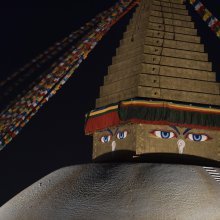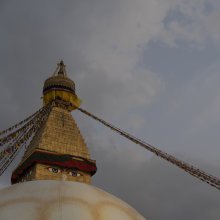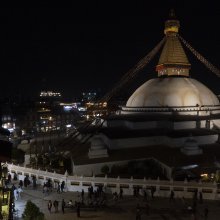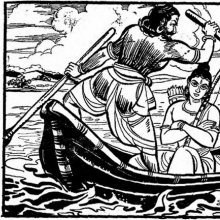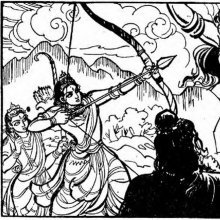Night: 3 definitions
Introduction:
Night means something in Hinduism, Sanskrit. If you want to know the exact meaning, history, etymology or English translation of this term then check out the descriptions on this page. Add your comment or reference to a book if you want to contribute to this summary article.
Images (photo gallery)
(+10 more images available)
In Hinduism
Natyashastra (theatrics and dramaturgy)
Source: Shodhganga: Elements of Art and Architecture in the Trtiyakhanda of the Visnudharmottarapurana (natya)Night (and Day) are associated with Sūcyāsyahasta: one of the twenty-two Single-hand Gestures (in Indian Dramas) (known as asaṃyuktahastas), according to the Viṣṇudharmottarapurāṇa, an ancient Sanskrit text which (being encyclopedic in nature) deals with a variety of cultural topics such as arts, architecture, music, grammar and astronomy.—The word sūcī means a tool which is used for stitching. It refers to the needle. [...] The Viṣṇudharmottarapurāṇa says that the natural phenomenon like day and night are denoted with this hand posture. It is also used to denote the eyes of Śakra and Maheśa.

Natyashastra (नाट्यशास्त्र, nāṭyaśāstra) refers to both the ancient Indian tradition (shastra) of performing arts, (natya—theatrics, drama, dance, music), as well as the name of a Sanskrit work dealing with these subjects. It also teaches the rules for composing Dramatic plays (nataka), construction and performance of Theater, and Poetic works (kavya).
Shilpashastra (iconography)
Source: Shodhganga: Elements of Art and Architecture in the Trtiyakhanda of the Visnudharmottarapurana (shilpa)Night and Day refers to classes of natural objects and phenomenon which follows specific guidelines in the tradition of ancient Indian Painting (citra), according to the Viṣṇudharmottarapurāṇa, an ancient Sanskrit text which (being encyclopedic in nature) deals with a variety of cultural topics such as arts, architecture, music, grammar and astronomy.—The Viṣṇudharmottarapurāṇa bears an elaborate description on the process of making the picture of some natural objects and phenomenon, e.g., night and day. [...] The Viṣṇudharmottarapurāṇa depicts that the picture of natural phenomenon like night should be drawn always with the moon, planets and stars. A beautiful picturisation of night with a sky full of stars and moon is found in the Kādamabarī. Again the Viṣṇudharmottarapurāṇa states that some concepts like the presence of thieves, sleeping person etc. are to be drawn in the picture of night. [...] Thus, the book addresses various elements of nature, such as night and day, since painting has much connection with time, mood and activity.

Shilpashastra (शिल्पशास्त्र, śilpaśāstra) represents the ancient Indian science (shastra) of creative arts (shilpa) such as sculpture, iconography and painting. Closely related to Vastushastra (architecture), they often share the same literature.
Yoga (school of philosophy)
Source: ORA: Amanaska (king of all yogas): A Critical Edition and Annotated Translation by Jason BirchThe Night can be denoted by the Sanskrit term Rātra, according to the Amanaska Yoga treatise dealing with meditation, absorption, yogic powers and liberation.—Accordingly, as Īśvara says to Vāmadeva: “[...] [Now], I shall define the nature of that highest, mind-free absorption which arises for those devoted to constant practice. [...] By means of an absorption for a day (ahan) and night (rātra), the Yogin who is steady in his seated posture knows smells from afar, because of the cessation of the activity of his mind. [...]”.

Yoga is originally considered a branch of Hindu philosophy (astika), but both ancient and modern Yoga combine the physical, mental and spiritual. Yoga teaches various physical techniques also known as āsanas (postures), used for various purposes (eg., meditation, contemplation, relaxation).
See also (Relevant definitions)
Starts with: Night bloom, Night jasmine, Night scented pelargonium, Night-blooming jasmine, Night-caps, Nightblooming cereus, Nightshade.
Ends with: Beauty-of-the-night, Good night, Growing at night.
Full-text (+3128): Ratri, Rajani, Nakta, Ahoratra, Kalaratri, Saptaratra, Triratra, Ganaratra, Sharvari, Nisa, Rajanicara, Nishitha, Yamika, Nish, Purvaratra, Ratra, Ekaratrika, Apararatra, Sharvara, Dviratra.
Relevant text
Search found 442 books and stories containing Night; (plurals include: Nights). You can also click to the full overview containing English textual excerpts. Below are direct links for the most relevant articles:
Manusmriti with the Commentary of Medhatithi (by Ganganatha Jha)
Verse 4.119 < [Section XIII - Days unfit for Study]
Verse 5.79 < [Section IX - Other forms of Impurity]
Verse 3.48 < [Section V - Duties of Marital Life]
Satapatha-brahmana (by Julius Eggeling)
Kāṇḍa XI, adhyāya 1, brāhmaṇa 7 < [Eleventh Kāṇḍa]
Kāṇḍa X, adhyāya 4, brāhmaṇa 3 < [Tenth Kāṇḍa]
Kāṇḍa XIII, adhyāya 2, brāhmaṇa 1 < [Thirteenth Kāṇḍa]
Rig Veda (translation and commentary) (by H. H. Wilson)
Vinaya Pitaka (1): Bhikkhu-vibhanga (the analysis of Monks’ rules) (by I. B. Horner)
The Agni Purana (by N. Gangadharan)
Chapter 195 - Vows relating to the week-days (vāra-vrata)
Chapter 157 - Pollution and Purification
Chapter 170 - The description of expiations for association with major sinners
Brahma Sutras (Shankaracharya) (by George Thibaut)
IV, 2, 19 < [Fourth Adhyāya, Second Pāda]
III, 4, 42 < [Third Adhyāya, Fourth Pāda]
II, 3, 12 < [Second Adhyāya, Third Pāda]
Related products
(+39 more products available)
